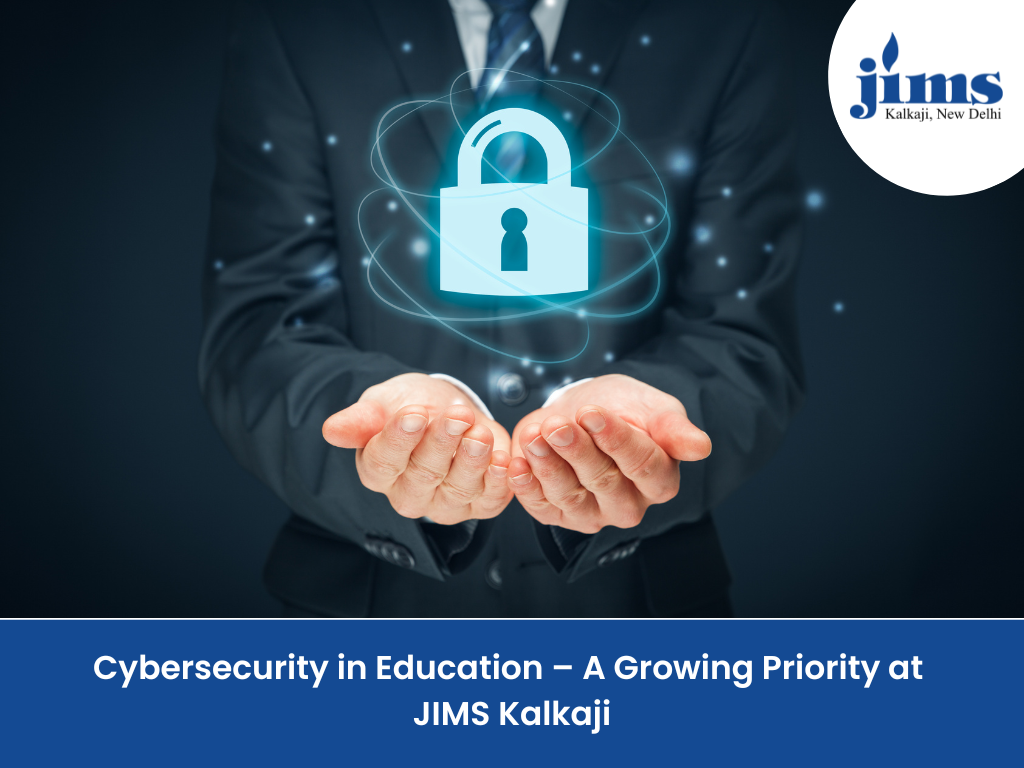
MS. JASMEET KAUR
Introduction: Why Cybersecurity Matters in Modern Education
In today’s digital world, educational institutions are no longer confined to physical campuses. Online learning portals, virtual classrooms, and cloud-based assessments have redefined how we teach and learn. At JIMS Kalkaji, a premier institute offering top-tier PGDM programs, we recognize that this digital shift also comes with critical responsibilities — and cybersecurity tops that list.
Cyber threats in education are rising, and as an academic community, we must work together to understand, prevent, and respond to them effectively.
Why Is the Education Sector a Target?
Colleges and business schools manage vast amounts of sensitive data — from student records and financial information to academic research. Unfortunately, many institutions lack advanced cybersecurity systems, making them attractive targets for cybercriminals.
For institutions like JIMS Kalkaji, which handle dynamic academic and administrative processes daily, protecting this data is essential to ensure academic integrity and institutional trust.
Key Cybersecurity Challenges in Educational Institutions
-
Phishing Attacks and Email Scams
Fake emails imitating university notices are common. Clicking these links can compromise student credentials or expose institutional data to hackers.
-
Ransomware Disruptions
A ransomware attack can lock down an entire college system — affecting exams, classes, and student records. The damage can be both academic and reputational.
-
Remote Learning Risks
Online learning tools, while convenient, can pose risks when used on unsecured devices or networks. Zoom/Meet links without passwords, shared devices, or weak logins all increase vulnerability.
-
Data Privacy Compliance
Institutions must now adhere to data protection laws like India’s DPDP Act, 2023. This requires clear policies on storing and handling personal data.
-
Bring Your Own Device (BYOD) Challenges
In PGDM programs, students often use their own laptops or mobile devices for coursework. If not properly secured, these devices can become entry points for malware or data leaks.
-
Low Awareness and Digital Hygiene
Many cyber incidents result from basic user mistakes — weak passwords, unverified downloads, or ignoring system updates. Awareness is key.
Steps JIMS Kalkaji Is Taking to Promote Cybersecurity
At JIMS Kalkaji, we are actively building a cyber-resilient campus environment. Here are some of the initiatives already in place or underway:
✅ Regular cyber awareness workshops for PGDM students and faculty
✅ Implementation of multi-factor authentication on internal systems
✅ Frequent data backups and encryption policies
✅ Updated firewalls and security patches across the network
✅ Institution-wide incident response planning
✅ Integration of digital responsibility topics into management education
Role of PGDM Students and Faculty in Cyber Safety
Everyone at JIMS Kalkaji — from first-year PGDM students to senior faculty — has a role to play. By adopting safe browsing practices, reporting suspicious activity, and using secure passwords, we contribute to a culture of digital accountability.
Faculty can further enhance this culture by integrating real-world cybersecurity examples into classroom discussions, especially in courses involving IT, digital business, or operations.
Conclusion: Building a Safer Digital Future
Cybersecurity is no longer just a technical concern — it’s a pillar of modern education. As a forward-thinking business school, JIMS Kalkaji is committed to fostering a secure learning environment for all. Whether it’s through cutting-edge PGDM programs or campus-wide digital initiatives, we believe that cybersecurity and education must go hand in hand.
Let’s work together to make our digital campus as secure and future-ready as the minds we’re shaping.

